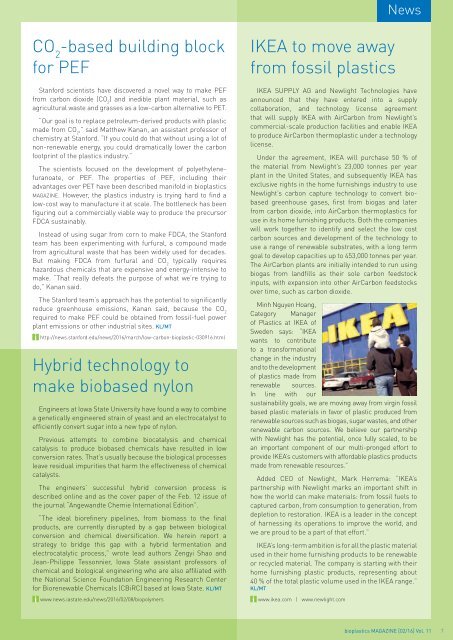Issue 02/2016
bioplasticsMAGAZINE_1602
bioplasticsMAGAZINE_1602
You also want an ePaper? Increase the reach of your titles
YUMPU automatically turns print PDFs into web optimized ePapers that Google loves.
News<br />
CO 2<br />
-based building block<br />
for PEF<br />
Stanford scientists have discovered a novel way to make PEF<br />
from carbon dioxide (CO 2<br />
) and inedible plant material, such as<br />
agricultural waste and grasses as a low-carbon alternative to PET.<br />
“Our goal is to replace petroleum-derived products with plastic<br />
made from CO 2<br />
,” said Matthew Kanan, an assistant professor of<br />
chemistry at Stanford. “If you could do that without using a lot of<br />
non-renewable energy, you could dramatically lower the carbon<br />
footprint of the plastics industry.”<br />
The scientists focused on the development of polyethylenefuranoate,<br />
or PEF. The properties of PEF, including their<br />
advantages over PET have been described manifold in bioplastics<br />
MAGAZINE. However, the plastics industry is trying hard to find a<br />
low-cost way to manufacture it at scale. The bottleneck has been<br />
figuring out a commercially viable way to produce the precursor<br />
FDCA sustainably.<br />
Instead of using sugar from corn to make FDCA, the Stanford<br />
team has been experimenting with furfural, a compound made<br />
from agricultural waste that has been widely used for decades.<br />
But making FDCA from furfural and CO 2<br />
typically requires<br />
hazardous chemicals that are expensive and energy-intensive to<br />
make. “That really defeats the purpose of what we’re trying to<br />
do,” Kanan said.<br />
The Stanford team’s approach has the potential to significantly<br />
reduce greenhouse emissions, Kanan said, because the CO 2<br />
required to make PEF could be obtained from fossil-fuel power<br />
plant emissions or other industrial sites. KL/MT<br />
http://news.stanford.edu/news/<strong>2016</strong>/march/low-carbon-bioplastic-030916.html<br />
Hybrid technology to<br />
make biobased nylon<br />
Engineers at Iowa State University have found a way to combine<br />
a genetically engineered strain of yeast and an electrocatalyst to<br />
efficiently convert sugar into a new type of nylon.<br />
Previous attempts to combine biocatalysis and chemical<br />
catalysis to produce biobased chemicals have resulted in low<br />
conversion rates. That’s usually because the biological processes<br />
leave residual impurities that harm the effectiveness of chemical<br />
catalysts.<br />
The engineers’ successful hybrid conversion process is<br />
described online and as the cover paper of the Feb. 12 issue of<br />
the journal “Angewandte Chemie International Edition”.<br />
“The ideal biorefinery pipelines, from biomass to the final<br />
products, are currently disrupted by a gap between biological<br />
conversion and chemical diversification. We herein report a<br />
strategy to bridge this gap with a hybrid fermentation and<br />
electrocatalytic process,” wrote lead authors Zengyi Shao and<br />
Jean-Philippe Tessonnier, Iowa State assistant professors of<br />
chemical and biological engineering who are also affiliated with<br />
the National Science Foundation Engineering Research Center<br />
for Biorenewable Chemicals (CBiRC) based at Iowa State. KL/MT<br />
www.news.iastate.edu/news/<strong>2016</strong>/<strong>02</strong>/08/biopolymers<br />
IKEA to move away<br />
from fossil plastics<br />
IKEA SUPPLY AG and Newlight Technologies have<br />
announced that they have entered into a supply<br />
collaboration, and technology license agreement<br />
that will supply IKEA with AirCarbon from Newlight’s<br />
commercial-scale production facilities and enable IKEA<br />
to produce AirCarbon thermoplastic under a technology<br />
license.<br />
Under the agreement, IKEA will purchase 50 % of<br />
the material from Newlight’s 23,000 tonnes per year<br />
plant in the United States, and subsequently IKEA has<br />
exclusive rights in the home furnishings industry to use<br />
Newlight’s carbon capture technology to convert biobased<br />
greenhouse gases, first from biogas and later<br />
from carbon dioxide, into AirCarbon thermoplastics for<br />
use in its home furnishing products. Both the companies<br />
will work together to identify and select the low cost<br />
carbon sources and development of the technology to<br />
use a range of renewable substrates, with a long term<br />
goal to develop capacities up to 453,000 tonnes per year.<br />
The AirCarbon plants are initially intended to run using<br />
biogas from landfills as their sole carbon feedstock<br />
inputs, with expansion into other AirCarbon feedstocks<br />
over time, such as carbon dioxide.<br />
Minh Nguyen Hoang,<br />
Category Manager<br />
of Plastics at IKEA of<br />
Sweden says: “IKEA<br />
wants to contribute<br />
to a transformational<br />
change in the industry<br />
and to the development<br />
of plastics made from<br />
renewable sources.<br />
In line with our<br />
sustainability goals, we are moving away from virgin fossil<br />
based plastic materials in favor of plastic produced from<br />
renewable sources such as biogas, sugar wastes, and other<br />
renewable carbon sources. We believe our partnership<br />
with Newlight has the potential, once fully scaled, to be<br />
an important component of our multi-pronged effort to<br />
provide IKEA’s customers with affordable plastics products<br />
made from renewable resources.”<br />
Added CEO of Newlight, Mark Herrema: “IKEA’s<br />
partnership with Newlight marks an important shift in<br />
how the world can make materials: from fossil fuels to<br />
captured carbon, from consumption to generation, from<br />
depletion to restoration. IKEA is a leader in the concept<br />
of harnessing its operations to improve the world, and<br />
we are proud to be a part of that effort.”<br />
IKEA’s long-term ambition is for all the plastic material<br />
used in their home furnishing products to be renewable<br />
or recycled material. The company is starting with their<br />
home furnishing plastic products, representing about<br />
40 % of the total plastic volume used in the IKEA range.”<br />
KL/MT<br />
www.ikea.com | www.newlight.com<br />
bioplastics MAGAZINE [<strong>02</strong>/16] Vol. 11 7


















